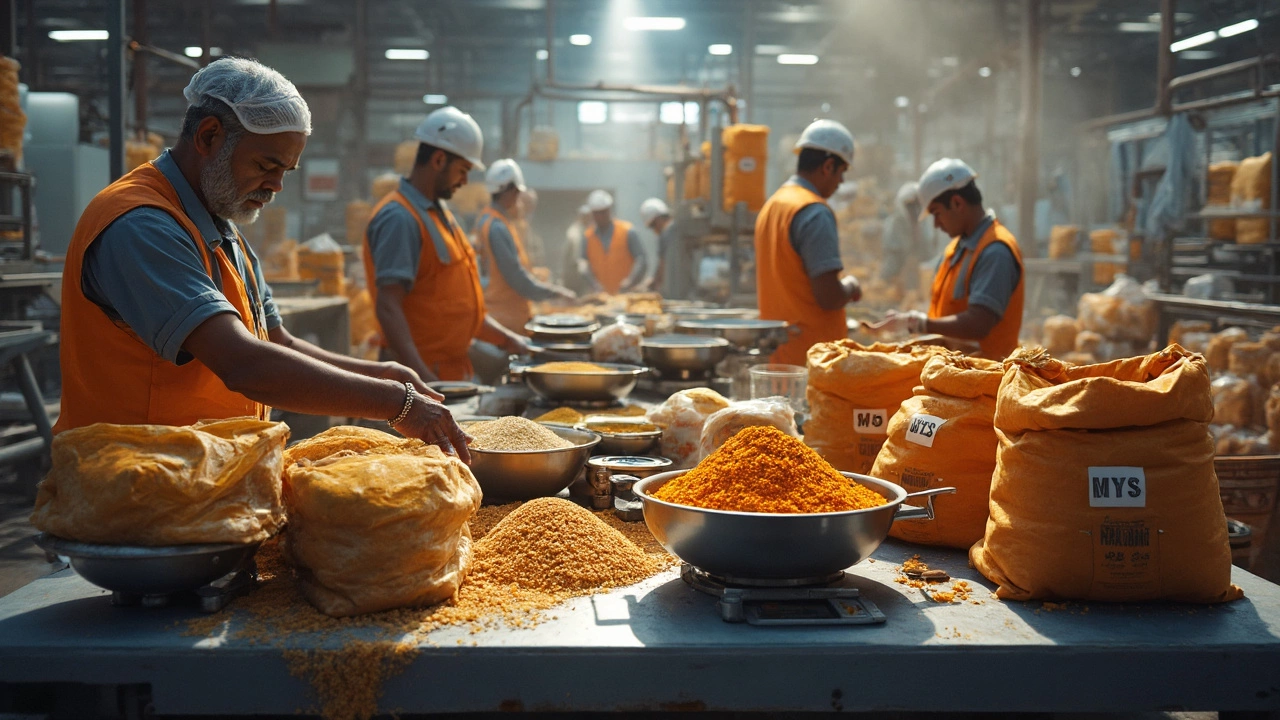MTS in Measurement: What It Means for Food Processing Units

If you ever spot 'MTS' on a food processing chart or a machine label and have no clue what it means, you’re not alone. A lot of people in the industry give each other blank looks at first. MTS, plain and simple, stands for 'Metric Tonnes.' That’s 1,000 kilograms—think about a stack of flour sacks higher than your kitchen ceiling.
Why does it matter? Food processing plants deal with big volumes. When you’re mixing starter cultures, batching dough, or prepping ingredients for mass production, knowing whether you’re measuring a few grams or a few metric tonnes keeps everything in order. Get the unit wrong, and you could waste ingredients or throw off a whole day's production.
- Breaking Down MTS: What Does It Stand For?
- How Is MTS Used in Food Processing?
- Why MTS Matters in Everyday Operations
- MTS vs. Other Measurement Units
- Tips for Managing MTS in Your Facility
Breaking Down MTS: What Does It Stand For?
The first thing to know: MTS stands for Metric Tonnes. It’s one of those units that crops up all the time in food processing, especially when you’re dealing with big batches. A metric tonne is exactly 1,000 kilograms. In other words, a metric tonne is more than twice as heavy as your average car. When you see "MTS" anywhere, it’s a sure sign we’re talking about large-scale quantities.
Most countries worldwide use the metric system, so metric tonnes are the default for shipments, ingredient mixing, and product labeling in global food operations. If you work at a food processing plant, you’ll see everything from ingredients arriving by the tonne to finished products shipped out in the same unit. The term is abbreviated as "t" or "MTS" in many reports and spreadsheets.
| Unit | Symbol | Weight (kg) | Common Use in Food Processing |
|---|---|---|---|
| Metric Tonne | MTS or t | 1,000 | Bulk orders, shipments, processing output |
| Kilogram | kg | 1 | Batch recipes, small-scale packing |
| Gram | g | 0.001 | Spices, additives, lab analysis |
You might also hear "ton" thrown around, which can make things confusing. In the US, a ton means 2,000 pounds (that’s about 907 kg), not the same as a metric tonne. That’s why MTS shows up on international paperwork—it avoids mix-ups and makes sure everyone’s on the same page, whether you’re shipping cocoa to Belgium or importing sugar in India.
If you’re in charge of inventory or logistics, always double-check your units. Mixing up ‘MTS’ with ‘tons’ can leave you short—or overstocked—by several truckloads. Food plants have actually lost money on contracts because someone confused these units in a spreadsheet or supply order.
How Is MTS Used in Food Processing?
MTS pops up everywhere in food processing, especially in places that move huge amounts of product. It’s the go-to unit for everything from tracking daily outputs to ordering bulk ingredients.
In modern food factories, a shipment manifest might list raw sugar arriving by the MTS. Big bakeries talk in MTS when scheduling flour deliveries. Meat processing plants, dairies, and even breweries check their incoming and outgoing weights in metric tonnes, so they always know exactly how much product moves through the doors.
The transport side of things loves this standard, because one MTS is easy to add up when estimating truck, train, or container loads. If you’re handling rice, grain, or other bulk materials, shipping rates are usually set by the metric tonne, making budgeting straightforward.
- MTS makes inventory numbers more manageable—nobody’s counting single bags when you’ve got pallets stacked high.
- It cuts down on mistakes too: a misread decimal with smaller units can mess up a batch, but rounding off to full MTSs leaves less room for error when planning production runs.
- Many governments ask food factories to report volumes in metric tonnes, which helps with food safety checks and export paperwork.
If you’re using management software or equipment with digital displays, chances are good that somewhere you'll enter or read off weights using MTS. Getting used to working with this unit can save you all sorts of headaches, especially once the orders and invoices start flying in.

Why MTS Matters in Everyday Operations
When you’re dealing with food processing at an industrial scale, accuracy isn’t just nice—it’s critical. Using MTS (Metric Tonnes) helps make sure everyone in the plant speaks the same language about amounts. If a recipe calls for 14 MTS of flour, that’s 14,000 kilograms; there’s no room for guessing or rounding off.
Consistent use of MTS cuts down mistakes. For example, if someone mixes up metric tonnes with short tons (which are common in the United States and equal about 907 kilograms), that one mistake could mean hundreds of kilos off target. That can mean ruined batches, rejected products, and wasted money.
Recording production in MTS also helps with tracking and reporting. Most food companies have to show exactly how much raw material comes in and how much finished product goes out, both for quality control and for things like audits or food safety checks. Using a standard unit like MTS keeps things clean and simple. It also lines up with international trade standards, making it easier to sell or buy ingredients globally.
Inventory systems, ordering routines, and even the way forklifts and trucks are loaded all use MTS for planning. Try shipping 30,000 kilograms of sugar without knowing how many MTS that is—you’ll end up with short shipments or a big mess at the loading dock. That’s why most big processors keep digital scales and tracking software set to metric units by default.
- If you ever have to convert between MTS and other common units, remember: 1 MTS equals 1,000 kilograms, or about 2,204.62 pounds. That conversion makes life much easier when equipment or suppliers use different units.
- Standardizing around MTS can help cut down on errors, simplify training for new staff, and improve supply chain coordination.
So, when it comes to large-scale food processing, MTS is more than just a number—it’s the backbone that keeps everything running smooth.
MTS vs. Other Measurement Units
So, what makes MTS stand out when you’re up to your elbows in food processing? Let’s cut through the confusion: in this world, accuracy matters and picking the right unit keeps things running smoothly—and legally right. MTS means Metric Tonnes, but there are a bunch of other units that pop up, from grams and kilograms to pounds and tons. Mix these up, even a little bit, and you might as well chuck your next batch.
Here’s how the most common units compare in food processing plants:
| Unit | Short Form | Amount | Where You'll See It Used |
|---|---|---|---|
| Metric Tonne | MTS, T, t | 1,000 kg | Bulk supply, grain processing, export volumes |
| Kilogram | kg | 1,000 grams | Ingredient mixing, labeling, recipe batching |
| Gram | g | 1/1,000 kg | Precision dosing, testing, food labs |
| Imperial Ton | Ton | 2,240 lbs (1,016 kg) | Exports to the UK, historical documents |
| US Ton (Short Ton) | Ton | 2,000 lbs (907 kg) | North American imports/exports |
| Pound | lb | 0.453 kg | Older recipes, US machinery, packaging |
Metric Tonne (MTS) is basically the 'go big or go home' unit. It’s the go-to for things like sugar deliveries, grain silos, or any ingredient you buy in huge amounts. Kilograms and grams are great for anything that needs precision, like seasoning blends or test recipes.
A big headache pops up when buyers and sellers get their metric and US tons mixed up. That’s a 90-kilo difference—picture an adult lion, and that’s what can go missing in your paperwork. It’s smart to confirm if the ton you’re dealing with is metric (MTS), imperial, or US. Most international food trade uses MTS as a standard, just to avoid this drama.
If you work in food processing, keep a conversion chart close. A lot of plants stick one right by the scales or mixing tanks, just in case. And when you’re reporting yields or planning shipments, double-check units to dodge expensive mix-ups.

Tips for Managing MTS in Your Facility
Handling MTS in a food processing setting isn’t rocket science—but if you try to wing it, you’re guaranteed a headache. People working with metric tonnes every day know that a small mistake can cost thousands. Here’s how to dodge the most common problems and stay on track.
- Label Everything Properly: Mark your storage bins, recipe sheets, ingredient containers, and production records with clear units ("kg," "g," and especially "MTS"). If you see mistakes, fix them fast before they spread.
- Train Staff Regularly: Get everyone used to working with metric units and what each abbreviation means. A quick quiz at shift changes or refresher posters in workrooms help new team members avoid costly slip-ups.
- Use the Right Scales: Not all weighing equipment goes above 1,000 kg. MTS calls for heavy-duty platform scales or load cells. Double-check your equipment’s capacity and regularly calibrate it—factory settings sometimes drift with wear.
- Track Your Inventory: Keeping close tabs on stock measured in metric tonnes makes ordering and reordering smoother. Misreading a "MTS" as just "kg" means you could end up with ten times less (or more!) product than you need.
- Audit Your Records: Once a month, pick a random record and check every line for the correct unit. Fixing a unit error on paper is way cheaper than fixing it on the production line.
Want to see a few quick real-world figures? Here’s what switching to metric tonnes can mean for inventory and deliveries in a mid-sized bakery that handles flour, sugar, and salt:
| Ingredient | Average Monthly Use (MTS) | Typical Delivery Size (kg) |
|---|---|---|
| Flour | 40 | 25,000 |
| Sugar | 8 | 8,000 |
| Salt | 1.2 | 1,200 |
When everyone’s clear on MTS, orders line up with demand, and you won’t see trucks showing up with way too much or not enough. It’s all about making the numbers work for your process, not the other way around.